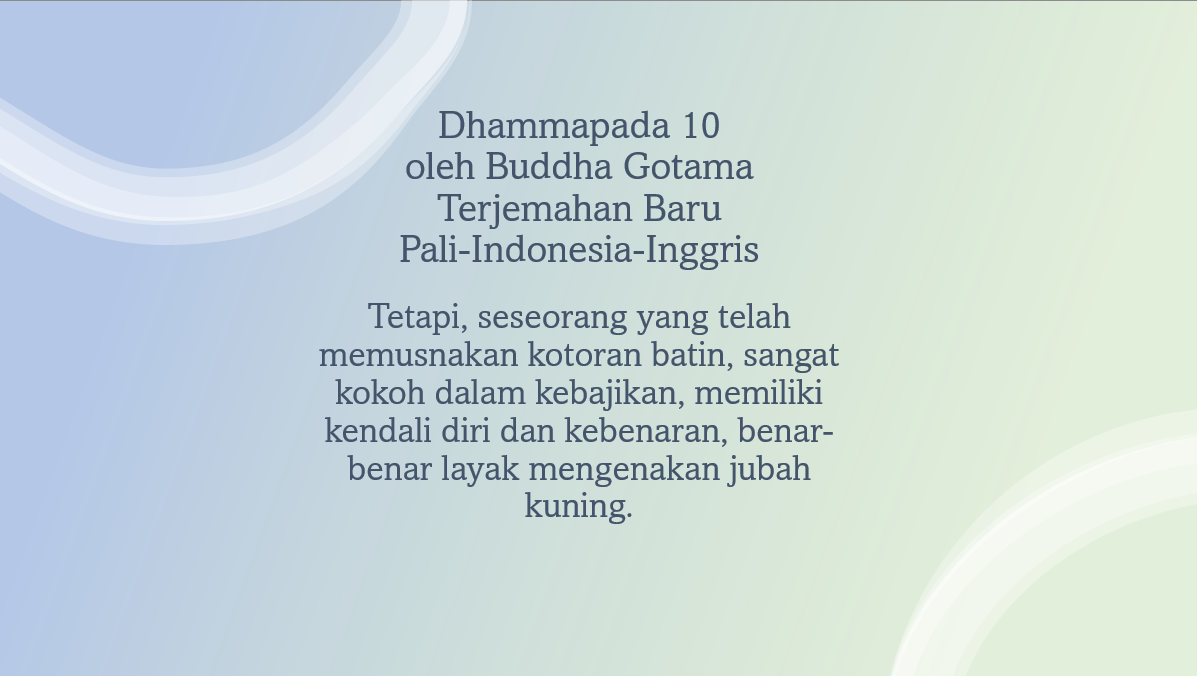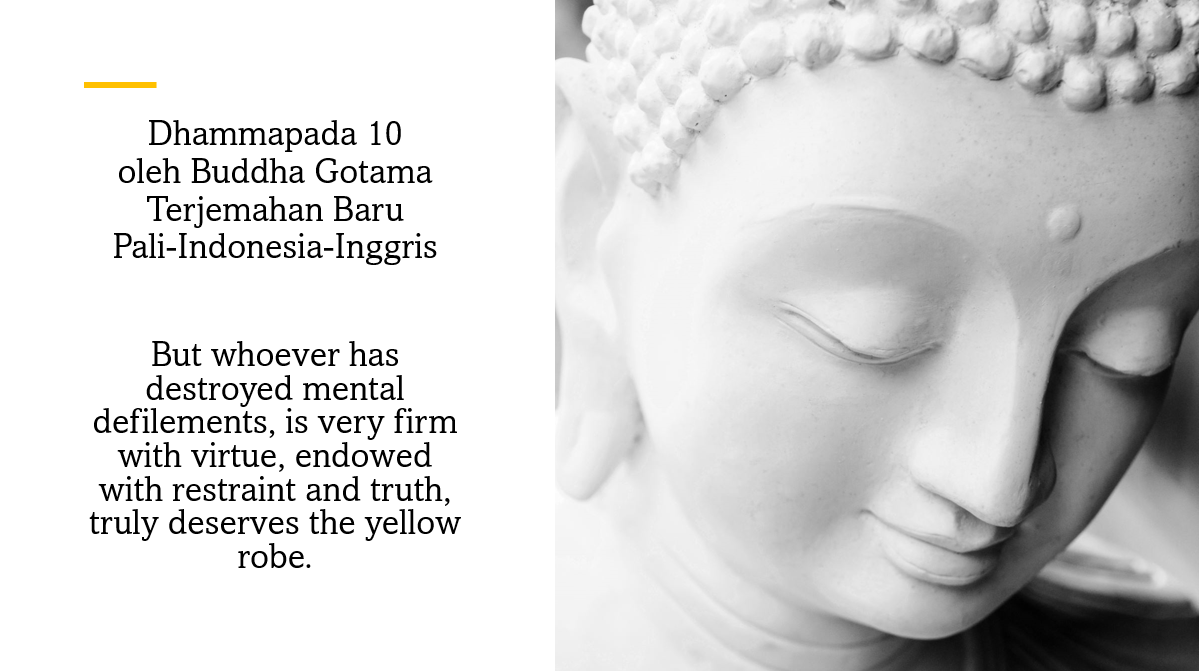Yamaka Vagga



Vocabulary 1 |
Vocabulary 2 |
Yo: sg.masc.nom. of the rel. pron. ya ‘he who’ = he whovantakasāv’assa: vantakasāvo+assa= vantakasāv’assa (euphonic sandhi) = (one who) would/could get rid of defilement;sīlesu: sīla (nt.) = virtue, sīlesu (loc. pl.) = in virtuesupeto: upata (adj. made of upa (pf. meaning ‘close by, near’ + past part. of √i ‘ go’ = endowed. upeto (masc. nom. sg.) = endowed |
damasaccena: dama (nt. derived from √dam ‘to domesticate, to tame’ = restraint; sacca (nt.) = truth; dama+sacca= damasacca (nt.) = restraint and truth; damasaccena (ins. sg.) by restraint and truthna ( part.) = no, notso (sg. masc. nom. of the personal pron so ‘he, this, that’ = hekāsāvamarahati: kāsāva (adj.) = yellow; kāsāvaṁ (sg. acc. nt.) = yellow; arahati (3rd pers. sg. pres. act. indic.), derived from √arah ‘to deserve’ = deserves; kāsāvaṁ + arahati = kāsāvamarahati = deserves the yellow (robe) |
Grammar:
1(a)(i) the construction with a double pronoun, that is, a relative pronoun (e.g., yo) …, a demonstrative pronoun (e.g., so) …. is typical of a Pali sentence with a relative pronoun phrase acting as the subordinate clause and the main clause following it after a comma (also known as the ya + ta construction); in this construction, the demonstrative pronouns so, sā, and taṁ are used as co-relative pronouns [Duroiselle, 1915/1997:153, No.592(1)]; (ii) The relative clause regularly precedes the main clause. The relative word introduces the clause, but may be preceded by indeclinables connecting the whole sentence to the narrative of which it forms a part (Warder, 1963/2001:71)
2vantakasāv’assa: (a) lit. has vomited all moral defilements; it means has discarded all moral defilements through the four-Path Knowledge (Magga ñāṇa) (Tin, 2003:5); (b) vantakasāv’assa: vantakasāvo+assa= vantakasāv’assa (euphonic sandhi)* = (one who) would get rid of defilement; vanta (adj. past part. of √vam ‘discard’) = vomitted, (fig.) discarded, got rid of, left behind; kasāva (masc.) defilement; vanta + kasāva = vantakasāva (adj.) = (one who has got oneself) rid of defilement; vantakasāvo (sg. masc. gen.) = of (one who has got oneself) rid of defilement; assa (3rd pers. sg. pot. act. of √as ‘ be’ = would be; (c)* vantakasāvo+assa= vantakasāv’assa (a euphonic sandhi):
3susamāhito: (a) susamāhita (adj. derived from su (pf. ‘well, thorough’ + saṁ* (pf. implying conjunction and completeness) + ā (pf. denoting a close relationship to the object or the aim of action expressed in the verb) + past part. of √dha ‘ put’ = well-settled; susamāhito (sg. masc. nom.) = well-settled; (b) It is unexpected that the opposite form, sīlesu asamāhito, unsteady in virtue, is not found in the corresponding line in the previous verse (Ānandajoti, www.ancient-buddhist-texts.net).
*saṁ- or saṁ:
saṁ- or saṃ-, an indeclinable prefix to verbal roots:* (1) implying a conjunction, e.g., with, together;’ (2) denoting (i) ’completeness,’ (opposite vi-):
(a)Duroiselle (1915/1997:14, No. 38) writes that the niggahīta when followed by a consonant may remain unchanged.
Examples:
- taṁ dhammaṁ kataṁ; (ii) taṁ khaṇaṁ; (iii) taṁ patto
(b) Nasal-nasal: a nasal consonant (ń, ñ, ṇ, n, or m) followed by another nasal consonant, is assimilated to the latter: saṁ-nisīdati > sannisīdati ‘he sinks down’ (Perniola, 2001:23, No.15(a);
a.1sam-: (a) before a labial (b, bh, m, p, or ph) [(i) thus forming nasal-nasal (Perniola, idem.) (ii) niggahīta, followed by a consonant, may be transformed into the nasal of the class to which that consonant belongs (Duroiselle, idem., p. 14, No.39)]: Sambuddha* (saṁ- + buddha), sampajāna ‘attentive, thoughtful, mindful, deliberate’ (saṁ + pajāna ‘understanding, distinguishing’)
(b) before a vowel: samativijjhati, derived from saṁ– +ativijjhati ‘(it) penetrates,’ samacchati ‘(she, she, or it, or one) sits together,’ derived from saṁ- + acchati ‘(she, he, it or one) sits
*Sambuddha: (a) saṁ- + buddha, which is derived from budh ‘to enlighten’ + -ta (a past participle suffix; if formed from a transitive verb, it makes a passive meaning ; otherwise, it forms an active meaning) = budhta > buddha ‘enlightened.’ This is as written by Perniola [idem., p. 17, No.13(a)] that when two mute consonants come together, the first is assimilated to the second since both are of the same strength:
yuj-ta > yutta ‘joined’
mad-ta > matta ‘intoxicated’
tadkāro > takkāro ‘he who does that’
sat-puriso > sappuriso ‘good man.’
The consonant t, however, preceded by one of the soft aspirate consonants gh, dh, or bh, is first shortened to d and then assimilation takes place:
labh-tum > labh-dum > laddhum ‘to bobtain’
lubh-ta > lubhda > luddha ‘greedy’
budh-ta > budh-da > buddha ‘enlightened ;’
(b) Duroiselle (ibid.,p 18, No.63) writes that when initial t follows a sonant aspirate (gh, jh, ḍh, dh, or bh), the assimilation is progressive: the final sonant aspirate loses its aspiration, the following t (surd) becomes sonant, viz. d, and, taking the aspiration which the final sonant has lost, becomes dh:
EXAMPLE:
√rudh+ta=rudh+da=rud+dha=ruddha
a.2saṁ– before (i) a surd (or sibilant) (s), labial (b, bh, m, p, or ph), or glide (or semi-vowel) (y,* or v):, e.g., saṁsara, Saṁbuddha,* saṁyojana,b saṁyutta;b

Remark: In the case of final bh, initial t having become dh, regressive assimilation takes place: √labh + ta = labh + da = lab + dha = laddha ‘(having) taken, obtained, received;’ (labhati ‘obtains, takes, receives’)
a.2.1 by assimilation, also san– before a dental (d, dh, t, th, or n), e.g., santapeti, sandahati;
a.3saṅ– or saṇ: (a) before a guttural (or velar) (k, kh, g, gh, and ṅ) or aspirate (h), e.g., (i)saṅgha ‘assembly, community, brotherhood, sisterhood, order, or a chapter of a certain Buddhist order, or a certain number of monks;’ (ii) saṅkhāra, saṅkhata, asaṅkheyya; (iii) saṇha ‘smooth, gentle, mild,’ (Andersen, 1907/2020:253); saṇheti ‘to brush down’ (Davids & Stede 1921-1925/2005, Part VII, p.131);’ (b) before retroflex, or cerebral: ḍ, ḍh, ṭ, ṭh, or ṇ: saṁ+ṭhiṭṭhati > saṇṭhiṭṭhati ‘stands;’ saṁ+ṭhānaṁ > saṇṭhānaṁ ‘position’ (called as assimilation or adaptation by Perniola, 1997:14, No. 11(b)]
a.4sañ- (i) before a palatal (c, ch, j, jh, or ñ), e.g., sañcarati [also found in Perniola, 1997:14, No.11(b)], sañchidati ‘to cut, ‘to destroy,’ sañjāti ‘birth, origin, outcome;’ sañjagghati ‘to joke,’ sañña ‘perception,’ viññū ‘intelligent, wise, learned, knowledgable;’ (ii) before a word beginning with e and the ñ, the initial e changes into ññ: taṁ+eva= taññeva, paccantaraṁ+eva= paccantaraññeva; (iii) before a word beginning with h: evaṁ hi kho= evañhi kho, taṁ+hitassa= tañhitassa (Duroiselle,1915/1997:14, No.40) [see also a.3(iii)];
a.5(i)sal- before the liquids l, ļ or ļh, e.g., sallakhetti ‘to observe,’ sallapati ‘to talk with;’ sa-before the liquid r, sometimes sā-, e.g., sāratta, sārambha (Davids & Stede 1921-1925/2005, Part IV:114, Geiger & Norman, 2005, § 74.3, & the present author’s own research);
(ii) Before initial l, the niggahīta of saṁ and puṁ is changed to l:
(i) saṁ+lakkhaṇā=sallakkhaṇā; (ii) paṭi saṁ līno=paṭisallīno; (iii) saṁ+lekko=sallekho (Duroiselle, 1915/1997:14, No.39); (iv)
puṁ+ligaṁ=pulligaṁ (idem., No.39);
a.6 Duroiselle( idem., No.39) writes that the niggahīta, when followed by a consonant, may be transformed into the nasal of the class to which that consonant belongs.
EXAMPLES with (the explanatory notes in the parentheses being added by the present author):
(xxv) raṇaṁ+jaho=ranañjaho (ñ belongs to the guttural (or velar) consonant class or group, consisting of g, gh, k, kh, and ń);
(xxvi) taṇhaṁ+karo=taṇhańkaro;
(xxvii) saṁ+ṭhito=saṇṭhito (ṇ belongs to the cerebral or retroflex) consonant class or group, consisting of ṭ, th, ḍ, ḍh, and ṇ);
(xxviii) jutiṁ+dharo=jutindharo (n belongs to the dental consonant class or group, consisting of d, dh, t, th, and n);
(xxix) saṁ+mato=sammato (m belongs to the (bi-)labial consonant class or group, consisting of b, bh, p, ph, and m);
(xxx) evaṁ+kho=evań kho [see (i)];
(xxxi) dhammaṁ+ca=dhammañca (ñ belongs to the palatal consonant class or group, consisting of c, ch, j, jh, and ñ);
(xxxii) taṁ+niccutaṁ=taññiccutaṁ;
bsaṁ- + yogo: the niggahīta following y is assimilated into the y, and both together may become ññ: saññogo
saṁ- + yuttaṁ: saññuttaṁ
Often, no coalescence takes place, and both letters remain unchanged:
saṁyuttaṁ, saṁyojanaṁ (Duroiselle, 1915/1997:14, No.41).
Examples taken by the present author from the other stanzas of the Dhammapada:
31: saṁyojanaṁ >saññojanaṁ
37: saṁyamessanti > saññamessanti
*(Davids & Stede 1921-1925/2005, Part IV:114, Geiger & Norman, 2005, § 74.3, & Tjan’s own research)
Davids & Stede (ibid.) writes that saṁ- (or saṃ–) is the second most frequently (16%) used prefix in Pali after vi- (19%).
4kasavamarahati: a euphonic combination of kāsāvaṁ+arahati with the niggahīta ṁ in kāsāvaṁ becoming m because it is followed by a vowel, namely, a in arahati (arahati= arhati (Geiger & Norman, 2005:22) (Duroiselle, 1915/1997:15, No.42): taṁ+ atthaṁ= tamatthaṁ; yaṁ+ahu= yamahu; kiṁ+etaṁ= kimetaṁ. Note: sometimes the niggahīta transforms into d before a vowel, e.g., etaṁ +attho= etadattho, etaṁ+eva= etadeva, etaṁ +avoca= etadavoca, yaṁ+idam= yadidam (Duroiselle, idem., No. 43).
Duroiselle (ibid.) remarks:
Rules 39 and 42 are not strictly adhered to in texts edited in Roman characters; in proses above all, niggahīta is allowed to remain unchanged before a vowel or consonant, even in the middle of a vowel sometimes; in poetry, the retention of niggahīta or its change to m before a vowel is regulated by the exigencies of the meteres.
Duroiselle (ibid., No. 43) also writes:” Sometimes niggahīta before a vowel may become d: (i) etaṁ+attho= atadattho; (ii) etaṁ+eva+ etadeva; (iii) etaṁ+avoca= etadavoca; (iv) yaṁ+anantaraṁ= yadannantaram; (v) yaṁ+idam= yadidam
Duroiselle (ibid, Nos. 44-46) further writes:” Niggahīta before a vowel or consonant may be elided; niggahīta may sometimes be inserted before a vowel or consonant; a vowel may be elided after niggahīta.”
(b) Tilbe (1899:10-11) writes that when niggahīta (ṁ) meets either a vowel or consonant, the group may remain intact; niggahīta may be elided; a vowel following niggahīta may be elided; or one of the following changes may occur (with the examples in the parentheses given by the present author):
(1) niggahīta preceding a vowel generally changes to m;.a.1 or if the vowel is e, the group changes to ññ;a4(ii)
(2) niggahīta followed by a mute [mute sonants: (i) gutturals: g, gh; (ii) palatals: j, jh; (iii) linguals (or retroflex): ḍ, ḍh; (iv) dentals: d, dh, (v) labials: b, bh; (vi) liquids: y, r, ļ, v; (vii) aspirant: h)] is generally changed to the nasal (ń, ñ, ṇ, n, or m) of the class (guttural: ń, palatal: ñ, lingual (or retroflex): ṇ, dental: n; or labial: m) to which the mute belongs;a
(3) when niggahīta is followed by y, the group may become ññ;b or
(4) when niggahīta precedes h, it may change to ñ.a.3(iii)
|
English 1: |
English 2: |
|
But one who is self-cleansed of stain, in moral conduct firmly set, having restraint and truthfulness is fit for the stainless robe. |
But one who, well placed in virtues, |
|
Indonesia 1: |
Indonesia 2: |
|
Namun seseorang yang mampu menyingkirkan semua noda batin, yang teguh dalam aturan moral, yang memiliki pengendalian diri dan kejujuran. Dia sesungguhnya patut menerima jubah kuning. |
Tetapi seseorang yang telah terbebas dari kekotoran batin, selalu berbuat baik, penuh pengendalian diri dan memahami Kebenaran, maka ia layak megenakan jubah bhikkhu. |




